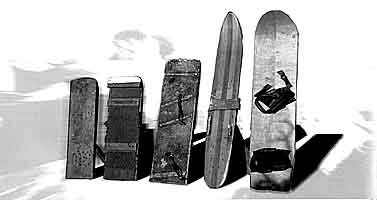Are you interesting in taking up snowboarding? Maybe you've got a pre-teen or teenager who was really fired up by watching snowboarding on television and it's the next big thing for them. Well, if you or your child join the ranks of snowboarding enthusiasts you will be part of a growing trend. The sale of snowboards has gone through the roof in the last decade, and especially the last few years. Perhaps the most evident symbol of the sport's success is that it has been an Olympic sport in the last four games, and viewership for snowboarding is generally extremely high. Before you get online and pick up a couple of snowboards, here's a brief primer about the sport.
You might be surprised to know it began as long ago as the late 1960's. Its inspirations are not hard to find - surfing, skateboarding and skiing. Early snowboards were pretty basic by today's standards, though the basic shape is still very similar. These early models had no boot or binding, just a small slot or groove to place your feet for stability. When snowboarding began to take off, the earliest and best snowboards were made by companies that are still making the best snowboards on the market - companies like Burton, Barefoot, Sims, and Gnu. Early on, many called the budding sport "snurfing," as you can guess, a combination of snow and surfing. Early designers of snowboards tended to be surfers and skateboarders, and the early models reflect these influences. Riders stand sideways on the board, unlike a forward position when skiing or water skiing.
In the late 1970's and early 80's snowboarding competitions began to crop up around the country in places like Michigan and Utah, then spreading to all the top winter sports areas. With time, rules became codified and the snowboards used had to meet certain design criteria for competition, since there were still a wide variety of types being experimented with. Initially, traditional skiers did not like the presence of snowboards on the slopes. Riders were often ill-versed in the etiquette of skiing, and accidents were not uncommon. Eventually, to solve the problem, innovative ski facilities began designating hills especially for snowboards. These hills contain moguls and rails that snowboards are designed to handle, and today more than half the ski facilities in the U.S. have half-pipes, a figure slightly ahead of Europe and Canada.
Modern snowboards are advanced pieces of equipment featuring specialized boots and bindings designed for the utmost control, stability and safety. Order a demonstration video along with your snowboards so you can get a jump on the basic techniques before you hit the half-pipe.
Snowboard savings - Why buy used when new is so cheap? Acutally there are some pretty good arguments. But either way check out a huge selection of snowboards on sale today. Visit http://snowboardsonsale.net/ for the latest offers.
Grab The Bookmarketer For Your Site

No comments:
Post a Comment